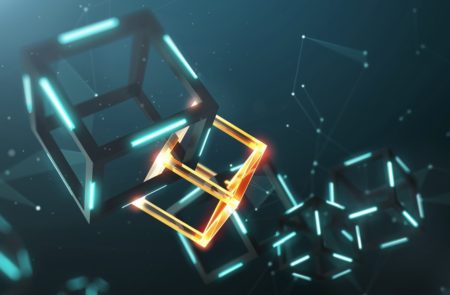June 3, 2019 – Peter Diamandis has shared his thoughts on blockchains, and through the go-to-expert on the subject, Eric Pulier described how this technology is evolving. What is holding back blockchains from wider usage are two things: 1. blockchains are by their distributed nature energy intensive, and 2. blockchains because of the interconnectedness of a decentralized database, not particularly fast. For businesses dealing in thousands of transactions per day using blockchain technology would be valid. But for transaction-intensive applications such as the buying and selling of shares, or banking transactions, blockchains as they are currently configured are unsuitable. And then there is the issue of environmental pollution from the potential source of energy needed to support blockchain transaction systems. But what follows are some interesting observations and forecasts about the future of the technology.
For those of you who don’t know what a blockchain is and how it works, here is a quick history and primer.
Blockchains emerged in 1991 as a way to timestamp digital documents but became much more widely-known in 2009 when Satoshi Nakamoto, whose true identity is disputed, used blockchain to create the cryptocurrency Bitcoin. What a blockchain is, is a decentralized database shared across a network of computers, or “nodes,” that can only be altered after approval from all the nodes in the system. Once information is created in a blockchain, it becomes very difficult to change.
Every block within a blockchain contains (1) data, (2) the hash, a digital fingerprint of the block, and (3) the hash from the previous block in the chain. Different types of data can be stored within blocks, including the name of the sender, the name of the receiver, and the transaction amount in the case of cryptocurrencies like Bitcoin. A block’s hash, generated using the data within the block, changes if that data is in any way altered.
Blockchains are seen as extremely secure because:
- Each block contains its own hash and the hash of the previous block, so changing one hash makes the rest of the blockchain invalid.
- Proof-of-work is the mechanism used to slow the creation of new blocks, and requires about 10 minutes per block in the case of a cryptocurrency like Bitcoin. The delay makes it extremely difficult to recreate the entire blockchain after changing data in one block.
- Consensus models vet computers that seek to join the blockchain requesting proof-of-work and proof-of-stake tests. Proof-of-work tests require nodes to solve computational challenges in exchange for receiving tokens, which are then used in proof-of-stake tests to achieve entry into a blockchain.
What’s Ahead for Blockchains in the Next Five Years
One of the most successful entrepreneurs in government and enterprise technology, Eric Pulier is the go-to expert on all things blockchain. The best-known venture capital groups in the world have financed companies that Pulier has founded or co-founded, including MediaPlatform, US Interactive, Desktone and SOA Software.
“Blockchain is a new way of looking at value and a new way of creating a transaction between parties where you don’t need a third-party intermediary and can track things and really have trust.” — Eric Pulier, Founder, CEO, vAtomic
Pulier’s predictions for blockchain trends for the next five years follow.
1. Non-fungible tokens (NFTs)
An NFT is a token on the Ethereum blockchain that contains unique metadata that differentiates it from other tokens. While currency is fungible and can be easily transferred, NFTs can be used to store much more complex and individual-specific information including government documents such as marriage certificates, land registrars, food-grade ratings, and driver’s licenses. In retail, consumers use can verify the legitimacy of luxury goods, digital goods, and tickets which can all easily be stored as NFTs on blockchains. Pulier predicts, “Now, the token, which is like a Bitcoin, can be a ticket, or a coupon, or a collectible. It could represent a real world good, like a coffee or a piece of art. So, what you’re going to see is the emergence of an entirely new space where non-fungible tokens are going to completely change the economy.”
2. Security tokens
Security tokens are cryptographic, programmable securities that serve as an asset that can also take action. Security tokens can pay dividends, pay interest, or even invest in other tokens or assets. Smart contracts, for instance, allow assets to automatically pay dividends on a specific date if all criteria are met. As Pulier explains, “Most of the tokens that you might be familiar with are called utility tokens, and they don’t represent a piece of a real-world object or of an actual equity. Security tokens are now emerging this year.” Security tokens have huge potential to decrease liquidity issues but will require additional infrastructure to take hold, such as their own exchanges, Security Token Offerings (STOs), and wallets.
3. Tokenized assets
“Everything that you can imagine that doesn’t have liquidity is going to be fractionalized and tokenized and put on exchanges,” predicts Pulier. Over the next five years, security tokens will start to represent a new form of liquidity in assets that traditionally have lacked liquidity, such as real estate or art. Pulier anticipates these assets will start trading 24/7, 365 days a year. Today, Malta and Switzerland are leading the way in developing the infrastructure for tokenized assets. The U.S. SEC and EUs ESMA have begun issuing comments about plans to put regulations in place.
4. Self-sovereign identity
As cyber attacks continue to proliferate, new forms of identity verification will emerge to protect users. Self-sovereign allows users to maintain a single digital identity across multiple platforms while selecting the information they wish to share on each. This mode of interaction would drastically transform the current digital marketplace that has turned personal data into a commodity. “Identity is going to be returned through blockchain back to the individual so that the individual will own their data and then be able to marshal it out based on what’s best for them as opposed to how Facebook or Google or other people may want to exploit it,” Pulier predicts.
In 2014, identity assurance processes cost the U.K. a staggering £3.3 billion. Self-sovereign identity would significantly reduce these costs. In e-commerce, online logins will be exponentially more secure and efficient. For financial services, Know-Your-Customer (KYC) and Anti-Money-Laundering (AML) work will be transferable from one bank to another, dramatically reducing costs. In healthcare, self-sovereign identities will put medical history records back into the hands of individual patients, and the transparency of permissible access will become the new standard.
5. Free speech
“Blockchain allows you to have an immutable record, something that no government can tear down no matter what, because a distributed ledger all over the world is going to undermine the despots, undermine the organizations and the governments that want to clamp down on free speech, and coupled with ubiquitous bandwidth, create a world where everybody is going to be able to have a voice. No speech is going to be able to be brought down or in some way kept away from the masses,” predicts Pulier.
The trend away from hierarchical societies towards networked structures has become increasingly prevalent over the last few decades. Blockchain will only accelerate this transition across the globe, unleashing profound social impacts. Enabling trust within vast networks of decentralized control, blockchain is about to unlock a phenomenon that few human societies have ever achieved before.
Final Thoughts
Operating as peer-to-peer decentralized “digital ledgers,” blockchains will reduce the spread of corrupted information, increase transparency, witness multiplied efficiency in countless processes, and cut out unnecessary intermediaries across almost every industry.
Within supply chains, blockchains will seamlessly record each touchpoint of an item, increasing production transparency for buyers who wish to make more informed purchase decisions. For elections anywhere, blockchain is poised to decentralize the voting process while maintaining fidelity to prevent election hacks. And in real estate, property record histories stored on blockchains will dramatically shorten the time invested in due diligence and financial verifications.
At the individual level, blockchain technologies will allow you to more easily verify your identity, share your health records, maximize gain from your financial assets, and track the origins of each purchase.
And at the broader societal level, blockchains will catalyze a sweeping shift away from hierarchical structures towards democratized networks at larger scales than ever before experienced by humankind. A next-generation tool capable of maintaining trust in large populations, blockchain will define a brand new order.
Although not mentioned in Pulier’s predictions, I see the use of blockchain to help in mitigating climate change. For example, blockchain can become a place for the trading of carbon credits and currency exchange for a carbon token of which a quantity could be issued to citizens based on an initial calculation of their personal carbon footprints. In this use of blockchain, citizens would be able to buy and sell carbon tokens with the buyers those who have run out of tokens before each year ends, and the sellers, those who have managed to reduce their carbon footprints leaving them with a surplus. Carbon tokens like Bitcoins could be converted into currency so that those who have lowered their carbon footprints could exchange the tokens for hard cash.















